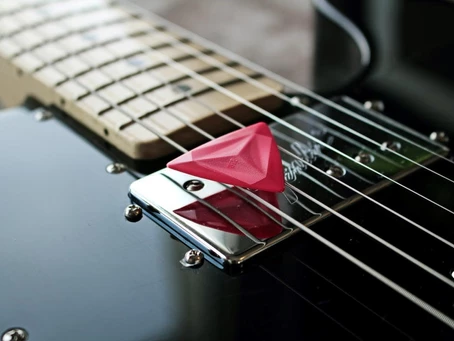Beginner and intermediate guitarists often overlook the importance of guitar picks. That’s because it’s hard to imagine that a small, insignificant piece of plastic can affect the guitar’s playability and tone.
Using the wrong guitar pick can slow your development and interfere with your technical abilities. So, you must know how to find the right pick and how each offers different playing styles. The tone of a guitar pick depends on the following factors.
Pick Thickness
Guitar picks are available in four general gauges:
- Thin – 40-60 mm or less
- Medium – 0.60-0.80 mm
- Heavy – 0.80-1.20 mm
- Extra Heavy – 1.20 mm+
Depending on the manufacturer, the ranges of guitar picks can vary considerably. They are typically divided into two categories – thin and thick.
Thin picks are better to use for brighter tones and tighter dynamic range. That’s because their striking surface produces high frequencies. Moreover, their flexibility limits the achievable volume, which works well for a studio recording. Thin picks also help improve acoustic guitar strumming because they add more clarity to every note and chord.
On the other hand, thick picks offer mellower tones, a wider dynamic range, and heavily distorted sounds. That’s because their rounder edges and heavier weight accentuate bass and reduce treble. In addition to allowing more speed and accuracy during fast solos, thick guitar picks also offer greater clarity and separation between notes.
Hardness
Even if thinner picks are made from harder material, you can notice that the added stiffness delivers performance characteristics that resemble that of thicker picks. However, thick but softer picks offer performance qualities closer to that of thinner picks.
Texture
The more textured a pick’s surface is, the more friction will be produced between the pick and your fingers. It also allows better grip, especially when you have sweaty fingers. Though better grip offers improved playability, texture also impacts how the pick rolls off the strings.
Smooth picks that slip off the strings produce a natural and cleaner tone, while rough picks add more grit to the tone.

Size and Shape
Smaller picks lower the distance between your hands and strings, making it easier to incorporate several hand techniques. A pick should typically be big enough to fit your hands. Moreover, the shape of your pick depends on the sharpness of the striking surface.
Sharper points have a stronger attack with a crisp tone and work well for solo playing, while rounder points have a softer attack and mellower tones that work better for strumming.
If you’re looking for high-quality guitars, Rock Guitars has got you covered. Our online guitar shop provides high-performance rock guitars that are handmade and designed by EddieA himself. Each of his guitars features faux rock and comfortable playing for both beginner and professional musicians. Get in touch with us for more information and details.


